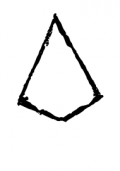Nayabaru architecture tends to pursue the symmetry-asymmetry of the diamond tree shape that also forms the basis of their alphabet glyphs:
This shape is often seen 1:1 in the design of windows. In other elements of design, it may be rotated, combined with other variants of itself, and nested within itself. The simplest Kiveki lights also have this shape.
Buildings
Or building, singular. A lot of Nayabaru communities combine the buildings that make up their community, at least visually. This isn't slavishly adhered to everywhere, but Vatenas in particular makes larger settlements into building complexes as a rule. Voskudat was especially building-like. (Sekine, on the other hand, was not - coastal towns prefer resilience against flooding and a single unified building would inhibit water flow, increasing damage from pressure and soaking.)
A focus when making combined structures like this is to ensure that each room still has access to natural air, where possible, meaning that a building may have several 'courtyards', many of which may be some degree of inaccessible. Common areas tend to be further into the structure. This means that it can just as well be true that you can only access the common areas by entering through someone's 'private' quarters.
Less constricted architecture tends to combine buildings with branch or root-like decorative structures, often in the form of arches across the roads, made of light material that can't cause much damage if it falls.
Lighting
As a rule of thumb, Nayabaru are obsessed with lights, and try to banish the night even if they sleep. The Kiveki lights that sit in their settlements are usually rather brighter than the guarded fires that inspired them, often making the insides of nearby houses lit as though by late morning twilight.
As Terenyira says in A Thread Between The Stars, “There can never be too much light amongst friends.” This also extends toward guiding lights at the coast: Najasar lights, the most extensive of which trace the coast of Sekine and Petraal.

